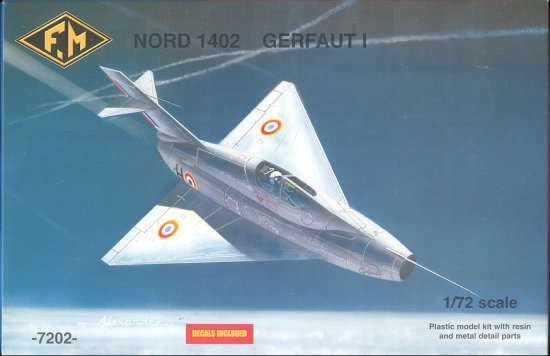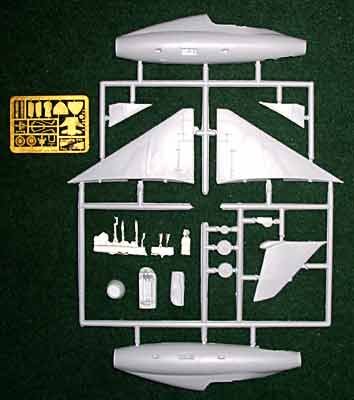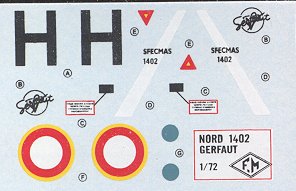
|
KIT: |
Fonderie Miniature (F.M.) 1/72 Nord 1402 Gerfaut I |
|
KIT # |
7202 |
|
PRICE: |
$29.95 ($26.97 at Squadron) |
|
DECALS: |
One aircraft |
|
REVIEWER: |
|
|
NOTES: |
Multimedia kitt with resin, vac and etched bits. |

|
HISTORY |
|
THE KIT |
 Upon opening the package for
this kit, I immediately went into a guilt trip for not having completed the
Griffon II kit sent a while back. It motivated me to get back to finishing
it!
Upon opening the package for
this kit, I immediately went into a guilt trip for not having completed the
Griffon II kit sent a while back. It motivated me to get back to finishing
it!
As you can see from the image, a lot of parts this kit hasn't. Doesn't mean it will be a snap build; I've learned over the years that it isn't necessarily the case and FM kits have generally proven to be quite challenging. The plastic is in the usual slightly pebbly surface with much flash on the fuselage parts (not shown in the image I swiped from the FM web page). This kit also has that greasy feel of mold release so be sure to wash everything quite well. The bits in the lower left of the image are the metal pieces on the top and the resin bits below that.
You have resin for the cockpit tub, nose wheel well and exhaust. The parts are well molded and it will be interesting to see if they are as brittle as those in the Griffon II. The metal bits are similar to previous efforts in that the mold has slipped providing some mismatch of parts. They are mostly landing gear, control stick, nose gear door and back of the bang seat as well as two small exhausts. The etched brass bits are for most of the rest of the teeny bits and includes the bottom of the bang seat, an arrangement which worked fairly well with the Griffon II. There are two vac canopies and they are well molded, unlike the flimsy excuses provided with the Griffon II.
 Instructions are a single
sheet of 8 1/2 by 11 paper folded in half. On the inside are three
construction steps. You do have to make a few bits out of wire and tube for
the pitots and various retraction struts for the landing gear as well as
one to hold the horizontal stabilizers in place. The back of this paper is
the decal and painting instructions. Like all these older research
aircraft, it was in natural metal. You'll have to paint the red and blue
rudder stripes as only the white stripe is provided. I can only hope that
they work fairly well as there are no aftermarket replacements for any of
these. If treated very gently and with no compound curves, they should work
fairly well. The image shown to right is about four times the actual size
of the sheet! As you can see, they are in good register and appear to be
opaque
Instructions are a single
sheet of 8 1/2 by 11 paper folded in half. On the inside are three
construction steps. You do have to make a few bits out of wire and tube for
the pitots and various retraction struts for the landing gear as well as
one to hold the horizontal stabilizers in place. The back of this paper is
the decal and painting instructions. Like all these older research
aircraft, it was in natural metal. You'll have to paint the red and blue
rudder stripes as only the white stripe is provided. I can only hope that
they work fairly well as there are no aftermarket replacements for any of
these. If treated very gently and with no compound curves, they should work
fairly well. The image shown to right is about four times the actual size
of the sheet! As you can see, they are in good register and appear to be
opaque
|
CONCLUSIONS |
Having built a couple of FM kits and working on one now, I have to be a bit cautious about them. They have a reputation for not being an easy build and I know several folks who have given up on some of the earlier kits that these folks have produced. The thing about FM and some others, is that they produce subjects that are just too cool to not have a go building them, and this one is headed right for the 'to do' pile.
You can find this kit and many others at

If you would like your product reviewed fairly and quickly by a site that has over 200,000 visitors a month, please contact me or see other details in the Note to Contributors.